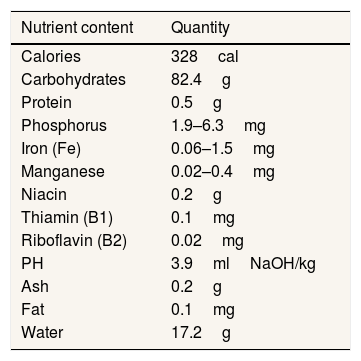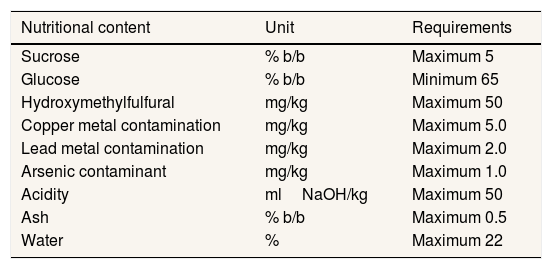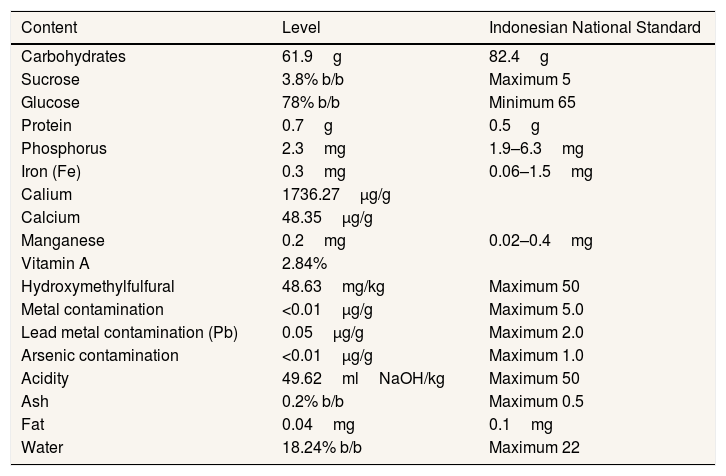
The 3rd International Nursing and Health Sciences Students and Health Care Professionals Conference (INHSP)
Más datosThis study is basic research carried out to measure the nutritional content of the honey cocktail product, an herbal therapy as a complementary treatment in addressing reproductive health problems and improving the nutritional status of preconception women. The purpose of this research is to know the ingredients in honey cocktail products.
MethodThe stage of this study is; choose a sample, processing honey cocktail, and testing the parameters. This study used three main raw materials, namely honey, royal jelly, and bee bread. The honey used is Trigona sp. The three primary raw materials used have been processed from the Halal Center of Hasanuddin University. Honey cocktail processing will use a mixture of 100g Trigona sp. honey, 100g royal jelly, and 100g bee bread, then be homogenized using a magnetic stirrer for ±15min. Honey quality testing is conducted to determine the nutritional content of the honey cocktail supplement, such as vitamins, minerals, proteins, fats, carbohydrates, sugars (sucrose and glucose), hydroxymethylfurfural, and metals, and water. This study also examined the metal contamination, ash, and fat level.
ResultsThe results of the test content in the cocktail honey supplement found in 100ml containing 61.9g carbohydrates, 0.7g of protein, 2.3mg of phosphorus, 0.3mg of iron, 1736.27μg/g of potassium, as much calcium 48.35μg/g, 0.2mg of manganese, 0.04mg of fat content, and 2.84% of vitamin A. in addition, cocktail honey also contains 3.8% sucrose, 78% glucose, HMF 48.63mg/kg, Cu <0.01μg/g, PB 0.05μg/g, arsenic <0.01, acidity 49.62ml NaOH/kg, an ash content of 0.2%, and moisture content of 18.24%.
ConclusionThe conclusion in this study cocktail honey samples meets the honey quality requirements following the Indonesian national standard. So that the cocktail honey supplement has good quality and is safe for consumption.
Cocktail honey is a mixture of royal jelly, bee bread, and honey that has undergone a mixing process and laboratory test results.1,2 Royal jelly is a product from bees other than honey produced from the hypopharyngeal glands of young bees. Royal jelly contains polyphenols, enzymes such as glucose oxidase, superoxide dismutase, vitamins B2, B1, B3, and vitamin C, which act as antioxidants.3 Royal Jelly is rich in protein and amino acids such as glutamic acid, tyrosine, methionine, tritopane, vitamin E, vitamin B5, and vitamin B6.4
Honey contains vitamins (A, E, C) that can prevent cancer, heart disease, infectious diseases, decreased neurological function, inflammation, and aging.5 In general, honey is nutritious for producing energy because the main content is high carbohydrates and is a simple sugar that is easy to digest.6 In addition, honey can also increase endurance and increase stamina.7 Honey products must have a moisture content below 22% and an acidity level with a maximum value of 50ml NaOH/kg (Indonesian National Standard, 2018). According to the U.S Patent Application Publication, the quality standard for the total value of sugar contained in honey ranges from 76-83oBrix.8
Several indications are used to test the quantity of royal jelly, bee bread, and honey as an indication that an herbal product is a product with original content or a mixture of artificial sweeteners, namely when the sucrose content of honey rises, enzyme levels fluctuate, ash content fluctuates, mineral content decreases, differences in aroma and taste, and the content of hydroxymethylfurfural (HMF) changes. HMF is a fraction of sucrose and fructose. The maximum content in honey is 50mg/kg if more than the honey is fake or mixed.
This study is basic research carried out to measure the nutritional content of the honey cocktail product, an herbal therapy as a complementary treatment in addressing reproductive health problems and improving the nutritional status of preconception women. The purpose of this research is to know the ingredients in honey cocktail products.
MethodsThis research was laboratory research. In this study, the researchers saw the laboratory test results from the honey cocktail sample, namely a mixture of 100g of Trigona honey, 100g of royal jelly, and 100g of bee bread, to see the quality and nutritional content of the sample.
Time and place of researchThis research was conducted in June 2020 in Makassar, South Sulawesi. Sample testing was carried out in 2 places: the manufacture of honey cocktails at the Phytoplankton Laboratory of the Faculty of Mathematics and Natural Sciences, Hasanuddin University, and the honey cocktail nutritional content testing will be carried out at the Makassar Health Laboratory Center.
Tools and materialsThe equipment used in this research was a vial bottle, digital scale, honey refractometer, magnetic stirrer, funnel, stopwatch, and transparent NaCl plate/drop plate. The materials to be used are royal jelly and bee bread obtained from the Faculty of Forestry, Hasanuddin University Makassar, and honey from Trigona sp which is obtained from the Halal Center of Hasanuddin University.
Research stageThe stage of this study are:choose a sample, processing honey cocktail, and testing the parameters. This study used three primary raw materials, namely honey, royal jelly, and bee bread. The honey used is Trigona sp. The three primary raw materials used have been processed from the Halal Center of Hasanuddin University. Honey cocktail processing will use a mixture of 100g Trigona sp. honey, 100g royal jelly, and 100g bee bread, then be homogenized using a magnetic stirrer for ±15min.
Honey quality testing is conducted to determine the quality of the nutritional content contained in the honey cocktail supplement. Such as vitamins, minerals, proteins, fats, carbohydrates, sugars (sucrose and glucose), hydroxymethylfurfural, metals, and water using a honey refractometer.
Test water contentWater content was measured with a honey refractometer. The method of measuring the honey refractometer uses a light plate given a few drops of honey to cover the blue boundary area with the scale value of the water content displayed in the viewfinder, which is expressed in percent (%).
Test sugar levelsSugar content was measured using a honey refractometer with the value of sugar content expressed in Brix units. Degree Brix, also known as °Brix, Brix,% Brix, is a measurement of the sugar concentration of a liquid.
Test of acidity (pH)The acidity (pH) of honey was tested using 0.1N NaOH solution. The result value is displayed in the viewfinder according to the Indonesian National Standard unit (2004).
Hydroxymethylfulfural (HMF) testHydroxymethylfulfural testing using a spectrophotometer with a wavelength of 284 and 336nm to determine the quality of honey expressed in mg/kg units according to SNI 2018.
Metal contamination testThe metal contamination test is following SNI 4866. The sample solution and the control solution are put into each test tube, and then the two solutions are put into a spectrophotometric device to measure their absorption.
Data managementThe data is presented using a quantitative table of the results of the analysis of the nutritional content of the honey cocktail using a comparison of the honey content according to the Indonesian National Standard on honey content standards (Tables 1 and 2).
Honey content according to the Indonesian National Standard on honey content standards (2013).
| Nutrient content | Quantity |
|---|---|
| Calories | 328cal |
| Carbohydrates | 82.4g |
| Protein | 0.5g |
| Phosphorus | 1.9–6.3mg |
| Iron (Fe) | 0.06–1.5mg |
| Manganese | 0.02–0.4mg |
| Niacin | 0.2g |
| Thiamin (B1) | 0.1mg |
| Riboflavin (B2) | 0.02mg |
| PH | 3.9mlNaOH/kg |
| Ash | 0.2g |
| Fat | 0.1mg |
| Water | 17.2g |
Description: Honey: Indonesia National Standart.
Requirements for the quality of honey-based on (Indonesian National Standard, 2018).
| Nutritional content | Unit | Requirements |
|---|---|---|
| Sucrose | % b/b | Maximum 5 |
| Glucose | % b/b | Minimum 65 |
| Hydroxymethylfulfural | mg/kg | Maximum 50 |
| Copper metal contamination | mg/kg | Maximum 5.0 |
| Lead metal contamination | mg/kg | Maximum 2.0 |
| Arsenic contaminant | mg/kg | Maximum 1.0 |
| Acidity | mlNaOH/kg | Maximum 50 |
| Ash | % b/b | Maximum 0.5 |
| Water | % | Maximum 22 |
Description: Quality of honey; Indonesia National Standard.
Based on the results of the examination of the content test of the honey cocktail product carried out at the Makassar Health Laboratory Center, the following results were obtained:
Based on Table 3, the honey cocktail contains as much as 61.9g of carbohydrates, 0.7g of protein, 2.3mg of phosphorus, 0.3mg of iron, 1736.27μg/g of potassium, 48.63 of calcium μg/g, 0.2mg manganese, 0.04mg fat content, and 2.84μg/g vitamin A. Requirements for the quality of honey in the 2018 Indonesian National Standard, namely the sucrose content in honey is a maximum of 5% while in the honey cocktail supplement it is 3.8%, the glucose or reducing sugar content is at least 65% and the honey cocktail is 78%, the maximum hydrometilfulfural cocktail honey is 48.63%, the maximum copper contamination content is 5mg/kg and in the honey cocktail supplement is <0.01μg/g, the maximum lead contamination contained in honey is 2mg/kg while in cocktail honey the amount of lead contamination is 0.05μg/g, the maximum level of arsenic contamination is 1mg/kg while in the honey cocktail it is <0.01μg/g, the maximum ash content in honey is 0.5%, while in the honey cocktail the ash contamination content is 0.2%, the maximum water content in honey is 22% while the honey cocktail supplement is 18.24%, and the acidity (pH) content in honey is a maximum of 50ml NaOH/kg while the acidity level in the honey cocktail is significant 49.62ml NaOH/kg. Therefore, examining the contents of the honey cocktail carried out at the Makassar Health Laboratory Center meets the food consumption requirements following Indonesian National Standards.
Content of cocktail honey.
| Content | Level | Indonesian National Standard |
|---|---|---|
| Carbohydrates | 61.9g | 82.4g |
| Sucrose | 3.8% b/b | Maximum 5 |
| Glucose | 78% b/b | Minimum 65 |
| Protein | 0.7g | 0.5g |
| Phosphorus | 2.3mg | 1.9–6.3mg |
| Iron (Fe) | 0.3mg | 0.06–1.5mg |
| Calium | 1736.27μg/g | |
| Calcium | 48.35μg/g | |
| Manganese | 0.2mg | 0.02–0.4mg |
| Vitamin A | 2.84% | |
| Hydroxymethylfulfural | 48.63mg/kg | Maximum 50 |
| Metal contamination | <0.01μg/g | Maximum 5.0 |
| Lead metal contamination (Pb) | 0.05μg/g | Maximum 2.0 |
| Arsenic contamination | <0.01μg/g | Maximum 1.0 |
| Acidity | 49.62mlNaOH/kg | Maximum 50 |
| Ash | 0.2% b/b | Maximum 0.5 |
| Fat | 0.04mg | 0.1mg |
| Water | 18.24% b/b | Maximum 22 |
Description: Cocktail honey; content.
The honey cocktail based on the results of the content test carried out has met the SNI 2018 requirements, such as the sucrose content of not more than 5%, namely 3.8%. If sucrose is hydrolyzed, it will produce monosaccharide molecules such as glucose and fructose.9 So that the sucrose level in honey does not exceed 5% because it will increase the glucose and fructose levels contained in honey. In addition, when there is an increase in sucrose levels in honey, it can be a sign that honey has been mixed with sugar.10 Reducing sugar levels in this case, namely, glucose, have a minimum requirement of 65%, while the honey cocktail supplement is 78%. Glucose can be absorbed directly by the blood without being changed first so that high glucose levels in honey will increase energy from its caloric content.11,12
Hydroxymethylfulfural (HMF) is an indicator of whether honey has been damaged due to excessive heating and added sugar.13 HMF standardization in honey is in accordance with the national standard of 50mg/kg. If the HMF content of honey is more than 50mg/kg, it can be ascertained that the honey is fake or mixed because of the added sugar from the mixed ingredients because it contains more sucrose.14 The content of HMF in cocktail honey is 48.63mg/kg, which is less than the maximum standard of honey HMF according to SNI 2018, which indicates that the honey cocktail has good quality. Compared with previous research on HMF testing on over-the-counter honey in Terasa Village, it shows that there is damage to the honey and the honey quality is not good.15
The content of copper, lead, and arsenic in honey can endanger health because it is toxic, which will cause inhibition of enzyme activity in hemoglobin formation resulting in anemia, causing brain damage, disorders of the nervous system, miscarriage, not developing embryonic brain cells, fetal death at birth.16,17 The number of losses incurred due to the presence of copper, lead, and arsenic, so that the government made standardization of copper, lead, and arsenic content from honey which is less than 5, 2, and 1mg/kg (Indonesian National Standard, 2018). Therefore, the copper, lead, and arsenic content in cocktail honey is <0.01, 0.05, and <0.01μg/g, which means that cocktail honey is safe for consumption. This is because the honey cocktail processing does not use tools made of metal and uses packaging made of glass.
The ash content in honey follows the maximum standard of 0.5% and the ash content in the honey cocktail is 0.2%. The ash content in honey products is due to the mineral content of the nectar and flower pollen sucked by the bees.18 However, if look at the national standard of maximum ash content in honey, cocktail honey has a lower ash content, which is 0.2%, which has an ash content that is safe for consumption.
The high acidity level in honey indicates that the honey has undergone a fermentation process, and the alcohol changes to organic acids. Higher levels of honey acidity mean lower levels of glucose and fructose.14 The storage temperature of honey also affects the acidity of the honey at low temperatures, the acidity of honey will decrease compared to room temperature. This is due to the high humidity level at room temperature so that the honey absorbs water more efficiently.19 The acidity level contained in the honey cocktail is 49.62ml NaOH/kg, less than the maximum standard of acidity of honey, which is 50ml NaOH/kg. 9.38%.20–22
The water content in the honey cocktail is 18.24% lower than the maximum standard of water content, which is 22%, which indicates that the honey quality is good. The high water content can be caused by adding water to the honey and the honeycomb, which is not covered with wax at harvest time.23 A beehive covered in wax is a good sign of ripening honey. In addition, the harvest age of the beehive can also influence the composition of the water in the hive. The longer the life of the honeycomb to be harvested, the better the evaporation of moisture content.13
ConclusionBased on the results of the content test on the honey cocktail supplement, it showed that the sucrose content was 3.8%, HMF 48.63mg/kg, Cu <0.01μg/g, Pb 0.05μg/g, arsenic <0.01μg/g, The acidity of 49.62ml NaOH/kg, 0.2% ash content, and 18.24% moisture content is less than the maximum standard of SNI 2018 and the content of reducing sugar (glucose) is more than the minimum standard of SNI which is 78%. This shows that the honey cocktail as an additional supplement for preconception women has good product quality.
Conflicts of interestThe authors declare no conflict of interest.
Peer-review under responsibility of the scientific committee of the 3rd International Nursing, Health Science Students & Health Care Professionals Conference.
















